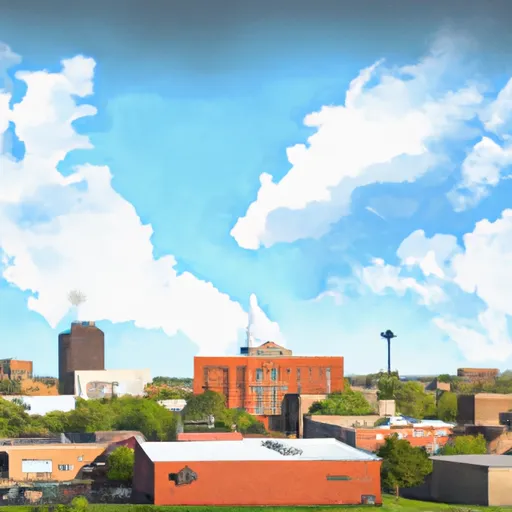-
 Snoflo Premium
Snoflo Premium
Get unlimited access to all our content
With no Ad interruptions! - Start Your Free Trial Login with existing account
Louisville
Eden Index
Climate
8.0
•
Recreation
4.4
•
Community
3.9
•
Safeguard
5.7/10

Louisville, Nebraska is a charming town located in Cass County. The region experiences a humid continental climate, characterized by hot summers and cold winters. Summers see average temperatures in the 80s°F, while winters can be chilly with average temperatures in the 20s°F. Precipitation is fairly evenly distributed throughout the year, with an average annual rainfall of around 32 inches and snowfall of about 30 inches.
The hydrology constituents of Louisville are primarily influenced by the nearby Platte River. The river plays a vital role in the region's economy and wildlife, providing water for irrigation and supporting various species of fish and birds. Additionally, there are several smaller streams and lakes in the area, offering opportunities for fishing and boating.
Outdoor enthusiasts will find plenty of recreational activities in Louisville. The Platte River offers excellent opportunities for kayaking, canoeing, and fishing. The surrounding countryside is ideal for hiking, biking, and bird-watching. The nearby Mahoney State Park provides a wide range of outdoor activities, including camping, horseback riding, and swimming in the park's aquatic center. With its diverse natural beauty and outdoor recreation options, Louisville is a haven for nature lovers.
What is the Eden Index?
The Snoflo Eden Index serves as a comprehensive rating system for regions, evaluating their desirability through a holistic assessment of climate health, outdoor recreation opportunities, and natural disaster risk, acknowledging the profound impact of these factors on livability and well-being.
Climate Health Indicator (CHI): 8.0
Louisville receives approximately
809mm of rain per year,
with humidity levels near 81%
and air temperatures averaging around
11°C.
Louisville has a plant hardyness factor of
5, meaning
plants and agriculture in this region thrive during a short period during spring and early summer. Most
plants will die off during the colder winter months.
By considering the ideal temperature range, reliable water supplies, clean air, and stable seasonal rain or snowpacks, the Climate Health Indicator (CHI) underscores the significance of a healthy climate as the foundation for quality living.
A healthy climate is paramount for ensuring a high quality of life and livability in a region, fostering both physical well-being and environmental harmony. This can be characterized by ideal temperatures, reliable access to water supplies, clean air, and consistent seasonal rain or snowpacks.
Weather Forecast
Streamflow Conditions
Lower Platte
Area Rivers
Lower Platte
Snowpack Depths
Lower Platte
Reservoir Storage Capacity
Lower Platte
Groundwater Levels
Recreational Opportunity Index (ROI): 4.4
The Recreational Opportunity Index (ROI) recognizes the value of outdoor recreational options, such as parks, hiking trails, camping sites, and fishing spots, while acknowledging that climate plays a pivotal role in ensuring the comfort and consistency of these experiences.
Access to outdoor recreational opportunities, encompassing activities such as parks, hiking, camping, and fishing, is crucial for overall well-being, and the climate plays a pivotal role in enabling and enhancing these experiences, ensuring that individuals can engage in nature-based activities comfortably and consistently.
Camping Areas
| Campground | Campsites | Reservations | Toilets | Showers | Elevation |
|---|---|---|---|---|---|
| Humboldt Lake Park | 12 | 982 ft | |||
| Iron Horse Trail Lake | 11 | 1,132 ft | |||
| Weeping Water | 25 | 1,081 ft | |||
| Centralia Lake | None | 1,285 ft | |||
| Louisville Lakes State Rec Area | 300 | 1,032 ft | |||
| Burchard Lake State Wildlife Area | 10 | 1,336 ft | |||
| Eugene T. Mahoney State Park | 150 | 1,167 ft | |||
| Walnut Creek - Papillion | 45 | 1,124 ft | |||
| Glenn Cunningham Lake | None | 1,130 ft | |||
| St Marys Riverside Park | None | 944 ft |
Nearby Ski Areas
Catastrophe Safeguard Index (CSI):
The Catastrophe Safeguard Index (CSI) recognizes that natural disaster risk, encompassing floods, fires, hurricanes, and tornadoes, can drastically affect safety and the overall appeal of an area.
The level of natural disaster risk in a region significantly affects safety and the overall livability, with climate change amplifying these risks by potentially increasing the frequency and intensity of events like floods, fires, hurricanes, and tornadoes, thereby posing substantial challenges to community resilience and well-being.
Community Resilience Indicator (CRI): 3.9
The Community Resilience Indicator (CRI) recognizes that education, healthcare, and socioeconomics are crucial to the well-being of a region. The CRI acknowledges the profound impact of these elements on residents' overall quality of life. By evaluating educational resources, healthcare accessibility, and economic inclusivity, the index captures the essential aspects that contribute to a thriving community, fostering resident satisfaction, equity, and social cohesion.

